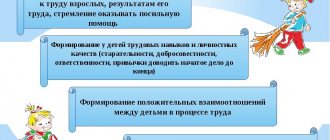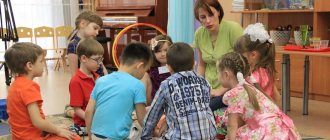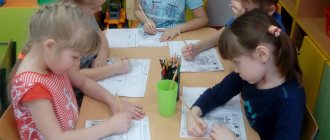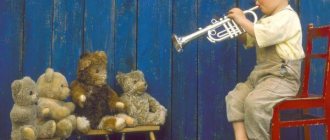The main components of a role-playing game:
Plot is a series of events taking place in a given area. For example, the game “family”, “doctor”, “store”. The main source for the game plot is the surrounding world, the activities of adults and peers, plots from books, cartoons and films (playing Iron Man, Winx Fairies, etc.). The variety of plots increases as the child becomes acquainted with new aspects of life. The plot reveals the content of the game.
The content of the game is what children highlight as the main point of activity and relationships between the participants in the plot, i.e. those actions that people (characters) perform in certain life situations. For example, a “mom” goes to the store to buy groceries, where she selects the products, puts them in a cart, pays the “salesperson” at the checkout, etc.
A role is a set of models and actions that are played out by children in the plot.
Didactic games
The most important importance of play activity is the development of children in its process. Didactic games conducted by teachers directly serve this purpose. These games are specially invented for training and education; they have certain rules and a specific result is expected. In fact, a didactic game is a synthesis of a form of learning and play. It sets didactic tasks, defines rules and game actions, and predicts the result. The didactic task refers to the educational impact and purpose of learning. It is well demonstrated by games that reinforce the ability to form words from letters or counting skills. The task in a didactic game is carried out through game actions. The game is based on the play actions carried out by the children themselves. The more interesting these actions are, the more effective and exciting the game will be. The teacher who controls the behavior of children sets the rules of the game. When the game ends, it is necessary to sum up its results. This may mean determining the winners who completed the task best, but at the same time it is necessary to encourage each participant in the game. Adults use didactic games as a way of learning, allowing a smooth transition from gaming to educational activities.
Stages of the role-playing game:
- The main content of the game for younger preschoolers ( 3–4 years old ) is to perform certain actions with toys. They repeat the same actions over and over again: “slicing bread,” “giving an injection,” “writing an email on the keyboard,” etc. At the same time, the result of the action is not used by children - no one eats sliced bread, no one reads the letter. Typically, children do not call themselves by the names of the persons whose roles they perform. The role is determined by the object itself: if a child has a saucepan in his hands (or an object that replaces it in the child’s imagination) - he is the “mother” preparing dinner; if there is a spoon, he is “mother’s child” who eats lunch. Moreover, the logic of the actions performed may fade into the background (one car can be driven by two “drivers”).
- In the middle of preschool childhood ( 4–5 years old ), the main content is relationships between people and social hierarchy, the roles of which children take on. Roles are clearly defined and highlighted. Children often divide roles among themselves before the game begins. This is the role relationship between seller and buyer, driver and passenger, doctor and patient - who should do what, and in what form he should do it. For example, a doctor must listen to the patient and give an injection. The actions performed by the child are not repeated and are replaced one after another. Actions are no longer performed for the sake of the actions themselves (the game of “slicing bread”), but to implement certain relationships with another player, in accordance with the role assumed.
- The content of the game for older preschoolers ( 6–7 years old ) is the fulfillment of the rules arising from the role taken on. Children begin to be extremely picky about following rules. When performing a particular role, they carefully monitor how consistent their actions, and the actions of their partners, are with generally accepted rules of behavior. It happens or it doesn’t happen - “The doctor must first listen and only then give an injection!”
The game reflects the character and living conditions of the child in the family and society. The same game (for example, family) can have completely different content: one “mother” will scold her “children”, another will put on makeup in front of the mirror and rush to visit, a third will read books to children, teach them, etc. All these options reflect what surrounds the child in life. The child has a desire to do the same things that adults do, but... he does not have the physical ability to do this, then the plot-role-playing game becomes a solution to this problem. A child can repeat the actions of an adult, in a form accessible to him, and partially join the adult world.
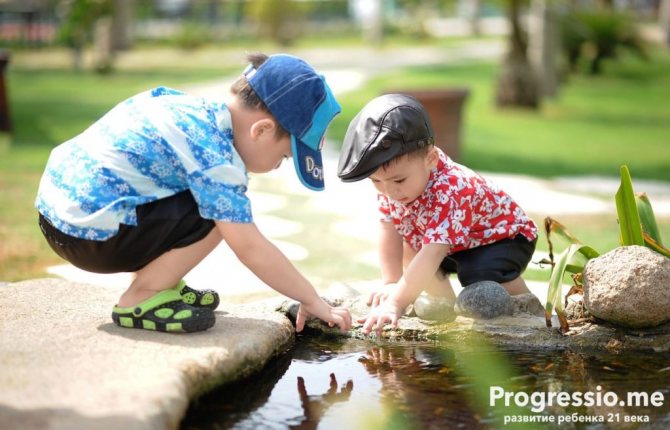
Formation of children's play activitiesconsultation on the topic
“Formation of children’s play activities”
Game is one of those types of children's activities that is used by adults to educate preschoolers, teaching them various actions with objects, methods and means of communication. In play, a child develops as a personality, he develops those aspects of his psyche on which the success of his educational and work activities, and his relationships with people will subsequently depend.
For example, in the game such a quality of a child’s personality is formed as self-regulation of actions taking into account the tasks of quantitative activity.
The most important achievement is the acquisition of a sense of collectivism. It not only characterizes the moral character of the child, but also significantly rebuilds his intellectual sphere, since in a collective game there is an interaction of different meanings, the development of event content and the achievement of a common game goal.
It has been proven that children gain their first experience of collective thinking through play. Scientists believe that children's games spontaneously but naturally arose as a reflection of the labor and social activities of adults. However, it is known that the ability to play does not arise through automatic transfer into play, learned in everyday life.
We need to get children involved in the game. And the success of society’s transmission of its culture to the younger generation depends on what content adults will invest in the games offered to children.
It should be emphasized that the fruitful development of social experience occurs only under the condition of the child’s own activity in the process of his activities. It turns out that if the teacher does not take into account the active nature of acquiring experience, the most perfect, at first glance, methodological techniques for teaching the game and managing the game do not achieve their practical goal.
The tasks of comprehensive education in play are successfully implemented only if the psychological basis of play activity is formed in each age period. This is due to the fact that the development of play is associated with significant progressive transformations in the child’s psyche, and, above all, in his intellectual sphere, which is the foundation for the development of all other aspects of the child’s personality.
The first stage in the development of gaming activity is the Introductory game. Based on the motive given to the child by an adult with the help of a toy object, it represents an object-based play activity. Its content consists of manipulation actions carried out in the process of examining an object. This activity of the baby very soon changes its content: the examination is aimed at identifying the characteristics of the object-toy and therefore develops into oriented actions-operations.
The next stage of gaming activity is called Display Game, in which individual object-specific operations become actions aimed at identifying the specific properties of an object and achieving with the help of this object
a certain effect. This is the culmination of the development of the psychological content of play in early childhood. It is he who creates the necessary soil for the formation of appropriate objective activity in the child.
At the turn of the first and second years of a child’s life, the development of play and objective activity converges and at the same time diverges. Now the differences begin to appear in the methods of action, the next stage in the development of the game begins: it becomes plot-representative. Its psychological content also changes: the child’s actions, while remaining objectively mediated, imitate in a conditional form the use of an object for its intended purpose. This is how the prerequisites for the role-playing game gradually become infected.
At this stage of development of the game, word and deed come together, and role-playing behavior becomes a model of relationships between people that are meaningful to children. The stage of the actual role-playing game begins, in which the players simulate the labor and social relations of people familiar to them.
A scientific understanding of the stage-by-stage development of play activity makes it possible to develop clearer, systematized recommendations for guiding the play activities of children in different age groups.
In order to achieve a genuine, emotionally rich game, including an intellectual solution to a game problem, the teacher needs to comprehensively guide the formation, namely: purposefully enrich the child’s tactical experience, gradually transferring it into a conventional game plan, and during independent games, encourage the preschooler to creatively reflect reality.
In addition, good play is an effective means of correcting disturbances in the emotional sphere of children brought up in unfavorable families.
Emotions cement the game, make it exciting, create a favorable climate for relationships, increase the tone that every child needs - a share of his mental comfort, and this, in turn, becomes a condition for the preschooler’s receptivity to educational actions and joint activities with peers.
The game is dynamic where the management is aimed at its gradual formation, taking into account those factors that ensure the timely development of gaming activity at all age levels. Here it is very important to rely on the child’s personal experience. Game actions formed on its basis acquire a special emotional overtones. Otherwise, learning to play becomes mechanical.
All components of a comprehensive guide to the formation of play are interconnected and equally important when working with young children.
As children grow older, the organization of their practical experience also changes, which is aimed at actively learning the real relationships between people in the process of joint activities. In this regard, the content of educational games and the conditions of the subject-game environment are updated. The emphasis of activating communication between adults and children shifts: it becomes businesslike, aimed at achieving joint goals. Adults act as one of the participants in the game, encouraging children to engage in joint discussions, statements, disputes, conversations, and contribute to the collective solution of game problems that reflect the joint social and labor activities of people.
So, the formation of play activity creates the necessary psychological conditions and favorable soil for the comprehensive development of the child. Comprehensive education of people, taking into account their age characteristics, requires systematization of the games used in practice, the establishment of connections between different forms of independent play and non-play activities, taking place in a playful form. As you know, any activity is determined by its motive, that is, by what this activity is aimed at. Play is an activity whose motive lies within itself. This means that the child plays because he wants to play, and not for the sake of obtaining some specific result, which is typical for everyday life, work and any other productive activity.
Play, on the one hand, creates a child’s zone of proximal development, and therefore is the leading activity in preschool age. This is due to the fact that new, more progressive types of activity are emerging in it and the formation of the ability to act collectively, creatively, and arbitrarily control one’s behavior. On the other hand, its content is nourished by productive activities and the ever-expanding life experiences of children.
The development of a child in play occurs, first of all, due to the varied focus of its content. There are games directly aimed at physical education (moving), aesthetic (musical), mental (didactic and story-based). Many of them at the same time contribute to moral education (role-playing games, dramatization games, action games, etc.).
All types of games can be combined into two large groups, which differ in the degree of direct participation of an adult, as well as different forms of children's activity.
The first group is games where an adult takes an indirect part in their preparation and conduct. The activity of children (subject to the formation of a certain level of game actions and skills) is of an initiative, creative nature - the children are able to independently set a game goal, develop the concept of the game and find the necessary ways to solve game problems. In independent games, conditions are created for children to show initiative, which always indicates a certain level of intelligence development.
Games of this group, which include plot and educational games, are especially valuable for their developmental function, which is of great importance for the overall mental development of each child.
The second group is various educational games in which an adult, telling the child the rules of the game or explaining the design of a toy, gives a fixed program of actions to achieve a certain result.
These games usually solve specific problems of education and training; they are aimed at mastering certain program material and rules that players must follow. Educational games are also important for the moral and aesthetic education of preschool children.
The activity of children in learning games is mainly reproductive in nature: children, solving game problems with a given program of actions, only reproduce the methods of their implementation. Based on their maturity and skills, children can start independent games that will have more elements of creativity.
The group of games with a fixed program of action includes active, didactic, musical, dramatization games, and entertainment games.
In addition to the games themselves, it should be said about the so-called non-game activities that do not take place in a playful form. This can be in a special way organized initial forms of child labor, some types of visual activities, familiarization with the environment while walking, etc.
Timely and correct use of various games in educational practice ensures the solution of the tasks set by the “program of education and training in kindergartens” in the most acceptable form for children. It should be noted that games have a significant advantage over specially organized classes in the sense that they create more favorable conditions for the active reflection of socially established experience in children's independent activities.
Finding answers to gaming problems increases children’s cognitive activity in real life. The processes of a child’s mental development achieved in the game significantly influence the possibilities of his systematic learning in the classroom and contribute to the improvement of his real moral and aesthetic position among peers and adults.
The progressive, developmental value of the game lies not only in the realization of the possibilities for the comprehensive development of the child, but also in the fact that it contributes to expanding the scope of their interests, the emergence of a need for classes and the formation of a motive for new educational activities, which is one of the most important factors in the child’s psychological readiness for learning. At school.
Mental education of children in play
In the game, the formation of perception, thinking, memory, speech occurs - those fundamental mental processes, without sufficient development of which it is impossible to talk about the education of a harmonious personality.
The level of development of a child’s thinking determines the nature of his activity and the intellectual level of its implementation.
The teacher must remember that any activity of children is aimed at solving a specific problem. The main task has many intermediate ones, the solution of which will transform the conditions and thereby facilitate the achievement of the goal. Practical problems that a child must solve differ from educational ones. The content of game tasks is dictated by life itself, the child’s environment, his experience, and knowledge.
The child gains experience in his own activities and learns a lot from teachers and parents. Various knowledge and impressions enrich his spiritual world, and all this is reflected in the game.
Solving game problems with the help of objective actions takes the form of using increasingly generalized game methods of understanding reality. The child drinks the doll from a cup, then replaces it with a cube and then simply puts his hand to the doll’s mouth. This means that the child solves game problems at a higher intellectual level.
It also happens in practice that the teacher, not understanding the meaning of the generalized playful actions of children’s thinking, demands from them collective actions that are as similar as possible to practical ones.
Firstly, if everything that happens to a child in everyday life is transferred to a game, then it will simply disappear, because its main feature - an imaginary situation - will disappear.
Secondly, the game, reflecting a well-known but poorly generalized life situation, involuntarily comes to a dead end. At the same time, it is known that in everyday life children receive not only clear, concrete knowledge, but also unclear, hypothetical ones. For example, a child knows who a sailor is, but he does not understand what he does. To clarify his ideas, during the game he asks questions and, having received an answer, acquires quite clear knowledge, but new information raises new questions. This is how the continuous process of knowledge occurs. It is accomplished in practical activities and in play. The game is a special form of cognition of the surrounding reality. The specificity of game tasks is that in them the goal is presented in an imaginary, imaginary form, which differs from a practical goal in that the expected result is not certain and its achievement is optional.
A very important point is to establish continuity of content beyond the gaming experience and the game. This is not about copying real objective actions in the game, but about understanding them and transferring them into the game. A more generalized game action transfers the game itself to a qualitatively new intellectual basis.
Particularly indicative is the replacement of a game action with a word. The motive of the game is not the action with objects, but the communication of children with each other, which reflects the interactions and relationships of people.
When the necessary level of thinking is formed, the child is able to replace the image of another person - take on a role and act in accordance with its content.
Formation of moral relations in the game
The educational potential of play is most fully realized with skillful pedagogical guidance, which ensures the necessary level of development of play activity.
Thus, children gradually learn moral standards through play and responsibility for performing actions increases. Psychologist D. B. Elkonin identified 3 stages of this process.
1. The child is focused on learning the properties and qualities of objects and the possibility of acting with them. Having satisfied his interest in objects, the child begins to show attention to the actions of other children playing nearby.
Thus, at this stage the foundation is laid for the further development of children's relationships.
.Children's interest moves to the sphere of relationships between adults.
The teacher, guiding the game, aims children at mastering moral norms that serve as the basis for humane human relations.
. The child subordinates objective actions, even the most attractive ones, to the main play goal, determined by the play role. The other person becomes the center of attention. Play actions are performed in a situation where their results are used for the benefit of other people, that is, the activities of preschool children acquire a social orientation. The main way to enrich the game with moral content is through familiarizing children with the phenomena of social life and cultivating positive attitudes towards them.
Ensuring the assimilation of the norms governing moral relations, while at the same time preserving the creative, amateur nature of the game, is possible only with proper pedagogical guidance.
With the help of game appeals, you can activate the moral relations formed in children and supplement the developing plot with numerous episodes. The teacher easily achieves the required goal if he enters into role-playing relationships with children. Advice, suggestions, questions, reminders from an adult should be addressed to the child - the performer of a certain role. The teacher leads the game, activating and improving the moral experience of the preschooler. As a result, independent communication in the game occurs at a fairly high moral level and is characterized by long-lasting, coherent relationships between all children.
Emotional development of children in play
The play of a preschooler is full of a wide variety of emotions, surprise, excitement, joy, delight, etc. This makes it possible to use play activities not only for the development and education of the child’s personality, but also for the prevention and correction of his mental states.
Many Soviet psychologists drew attention to the existence of a special, emotional game plan. They emphasized that the main meaning of the game lies in the variety of interactions that are significant for the child, and that during the game there are deep transformations of the initial, affective tendencies and intentions that are embedded in his life experience. The relationship between play and the emotional state of children appears on two levels: the establishment and improvement of play activity affects the emergence and development of emotions, formed emotions affect the development of a game of a certain content.
The different nature of the experiences that arise during the game allows us to distinguish two types of emotional behavior in young children.
Emotionally active people have a pronounced interest in play in general and in actions with one or more objects. They play for a long time. They perform a large number of actions with toys, many of which result in immediate, pronounced reactions: laughter, surprise, delight, etc.
For emotionally passive children, play has the character of a cursory, superficial familiarization with toys. The total time of their activity is short. Emotional manifestations are extremely poor. There is no pronounced joy or surprise.
The development of emotions that arise during actions with characters is important for the development of the game, and for the development of moral qualities of the individual.
A necessary condition for the emergence of a full-fledged game is the deployment of social content in it - the content of communication, interaction and relationships between characters. Observing the game makes it possible to determine how relationships with peers develop. The range of emotions addressed to a playing partner can be extremely wide: from complete indifference and ignorance to interest and support for emotional contacts, meaningful communication, and mutual actions. Emotional manifestations that arise in a specific game situation can be consolidated and generalized; the teacher must organize the game in such a way as to prevent the emergence and development of negative emotions, inattention, and aggressiveness.
It should be especially emphasized that the level of a child’s emotional orientation toward a peer and the nature of emotional responsiveness reveal a close connection with the level of development of play. Negative emotions flourish most often when children do not know how to organize and develop play.
However, greater efficiency can be achieved with the participation of the teacher himself in the game. By taking on the role, the adult indirectly controls the game, leading children out of conflict situations and warning them. This is especially successful in cases where the teacher knows well the life situations and play interests of children and delicately, unobtrusively uses his knowledge to maintain a positive attitude towards the game and partners.
Having determined the importance of children's play for the comprehensive development of a child's personality, we will now consider various approaches to the study of the play activity of mentally retarded children, first considering the features of the higher nervous activity of these problem children.
Other types of games:
- A game with rules is a game with a hidden imaginary situation and a hidden game role, but open rules. For example, in a game of hopscotch, you need to achieve a goal by observing a number of conditions that are agreed upon in advance. Games with rules differ from role-playing games in that here the rule is addressed to the child himself, and not to the game character. These games also include board games.
- Director's game - the child acts as the director of the game, where he controls dolls or soldiers, who are assigned certain roles and who perform certain actions (plot).
- Dramatization game - children take on the roles of heroes of films, cartoons, books and other cultural works. But unlike role-playing games, children do not invent the script and plot themselves, but borrow from the work being played out. This game appears closer to school age.
- Effective games - the goal of the game is to achieve a result that shows the degree of development of a certain ability of the child (who will run faster, who will throw a stone further).
- A didactic game is an educational activity that takes place in the form of various types of games.
- Computer games and games on mobile devices may include some components from the above types of games.
The role of play in child development
Playing is a mandatory activity for a child.
- It liberates him, so the baby plays with pleasure and without coercion. From the first weeks of life, the baby is already trying to interact with the rattles suspended above his crib.
- In preschool age, play activities teach children order and observance of rules.
- During the game, children strive to demonstrate all their skills (especially when playing with peers).
- Passion appears, many abilities are activated, the game creates an environment around the baby, helps to find friends and establish contacts.
- While playing, the child learns to find a way out and solve problems.
- The rules of the game teach him to be honest, and when they are violated, there follows general indignation among the players.
- A child can show qualities in play that are invisible in everyday life.
- In addition, the game reveals rivalry between children, which will help them defend their position and survive.
- Games have a beneficial effect on the development of imagination, thinking and wit.
- Gradually, through play activities, the child prepares to enter adulthood.
The influence of the game on mental development
- Performing a play role (focusing on a mental model), the child subordinates all his impulsive actions to this task. This contributes to the development of his self-regulation, arbitrariness of behavior and self-awareness.
- By performing different roles, the child gains different perspectives and can look from a different perspective. Thanks to this, decentration occurs - the most important mental ability of a person, which allows you to imagine a different view and a different point of view.
- Speech, communication skills and the emotional sphere develop.
- Cognitive and educational processes are improved: imagination, attention, memory, perception, visual-figurative thinking.
- Other types of activities arise within the game: productive, educational, labor.
Play and development of children's speech
Play even significantly influences the development of a child’s speech. A minimum level of communication skills is necessary so that the child can confidently connect to a gaming situation. Thanks to the need to communicate with other children, the development of coherent speech is stimulated. In play, which is the leading form of activity at this age, the sign function of speech intensively develops due to the replacement of one object with another. Placeholder objects serve as symbols for missing items. Any real object that replaces another object can serve as a sign. The proxy object transforms the verbal definition by associating the word with the missing object. Thanks to play, the child begins to perceive individual and iconic signs. In iconic signs, the sensory properties are virtually close to the object being replaced, and the sensory nature of individual signs has little connection with the designated object. Games are also important for developing reflective thinking. For example, a child playing hospital cries and suffers like a patient, although internally he enjoys playing the role.


